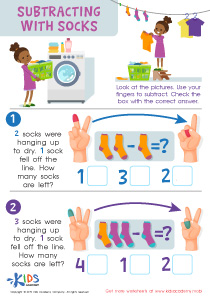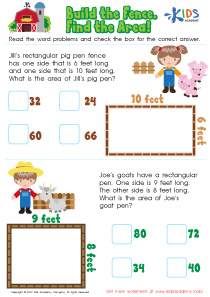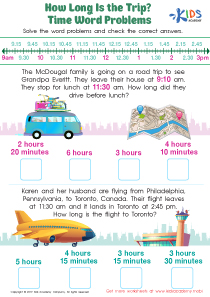Length and Mass Word Problems Worksheets for 3-Year-Olds
1 filtered results
-
From - To
Introduce your little one to the fundamentals of measurement with our engaging Length and Mass Word Problems worksheets! Perfectly tailored for children aged three years old, these learning worksheets blend fun and education to establish a strong foundation in basic concepts of length and mass. Through colorful and interactive activities, children will explore and solve simple problems, enhancing their early mathematical skills. Each worksheet is designed to capture young imaginations, making learning both enjoyable and effective. Start your child's journey into the world of math with our delightful set of worksheets, crafted just for their curious minds.


Length Word Problems Worksheet
The Value of Learning Printables: Worksheets on Length and Mass Word Problems for Three-Year-Olds
In the early years of child development, every parent and educator seeks to provide the best foundational learning experiences that will support a child's growth and understanding of the world. One effective tool in this educational endeavor is the use of learning printables, particularly worksheets focused on length and mass word problems. These resources are tailored to meet the developmental needs and curiosity of three-year-old children, helping them explore basic concepts of measurement in a fun and engaging way.
Engaging Young Minds with Practical Concepts
Learning printables, such as worksheets on length and mass, introduce young learners to the fundamental ideas of measurement. These concepts are part of everyday life—how tall are you? How heavy is your toy? By presenting these questions in a structured yet playful manner, worksheets help children make sense of their environment. They begin to understand that numbers and measurements are not just abstract concepts but are actually connected to real-world objects and experiences.
Developmentally Appropriate Learning
For three-year-olds, learning is best achieved through play and direct interaction with physical objects. Learning printables designed for this age group often incorporate colorful images and simple, relatable scenarios to illustrate concepts like taller vs. shorter or heavier vs. lighter. These worksheets are not just about filling out answers but are crafted to stimulate visual and tactile learning through comparison and recognition.
Cognitive Skills Enhancement
Worksheets on length and mass word problems also play a critical role in enhancing cognitive skills. They challenge young children to think critically as they compare sizes and weights, fostering early analytical and reasoning skills. This kind of problem-solving activity encourages children to make connections between symbols (like numbers and measurement units) and their meanings, which is a foundational math skill.
Language and Vocabulary Development
Interestingly, while the primary focus of these worksheets is on math, they also significantly contribute to language development. As children discuss and explain their understanding of the worksheets, they learn new vocabulary related to measurement. Terms like length, width, height, mass, heavy, light, big, and small become part of their everyday vocabulary, enhancing their communication skills and their ability to express complex ideas.
Building Confidence and Independence
The structured nature of learning printables allows children to work through problems at their own pace, providing them with a sense of achievement as they complete each task. This boosts their confidence and encourages a positive attitude towards learning. As children become familiar with handling these concepts through worksheets, they also develop a greater degree of independence in their learning journey. They learn to follow directions, recognize patterns, and even begin to check their work, skills which are valuable across all areas of education.
Preparation for Future Mathematical Concepts
Starting with worksheets on length and mass sets a strong foundation for more complex mathematical concepts that children will encounter as they grow. Early exposure to these measurement worksheets ensures that children are comfortable with basic math principles, paving the way for understanding more advanced subjects such as geometry, algebra, and data analysis in the future.
Parent and Educator Engagement
Learning printables also offer a wonderful opportunity for parents and educators to engage directly with the learning process. They can guide the children through the worksheets, discussing the concepts being taught and providing real-world examples to deepen the child's understanding. This active involvement not only enhances the learning experience but also strengthens the bond between the child and the adult, making learning a shared, enjoyable venture.
Adjustability and Accessibility
Another significant advantage of using learning printables like worksheets on length and mass is their adjustability and accessibility. These resources can be easily adjusted to suit the learning pace and style of each child, making them a versatile tool in both home and classroom settings. They are also readily accessible, often available for download and print, allowing for quick setup of a learning activity without the need for extensive resources.
Conclusion
In conclusion, worksheets on length and mass are more than just simple paper activities—they are a gateway to understanding the world for three-year-olds. By providing these learning printables, we equip our children with the tools to explore, understand, and interact with the world around them through the lens of measurement. They help lay down the cognitive, linguistic, and mathematical groundwork that will support the children in their ongoing educational journey, making learning both effective and delightful. As such, incorporating these worksheets into the daily learning routine of three-year-olds is not only beneficial but essential for building robust foundational skills.
 Assign to the classroom
Assign to the classroom





